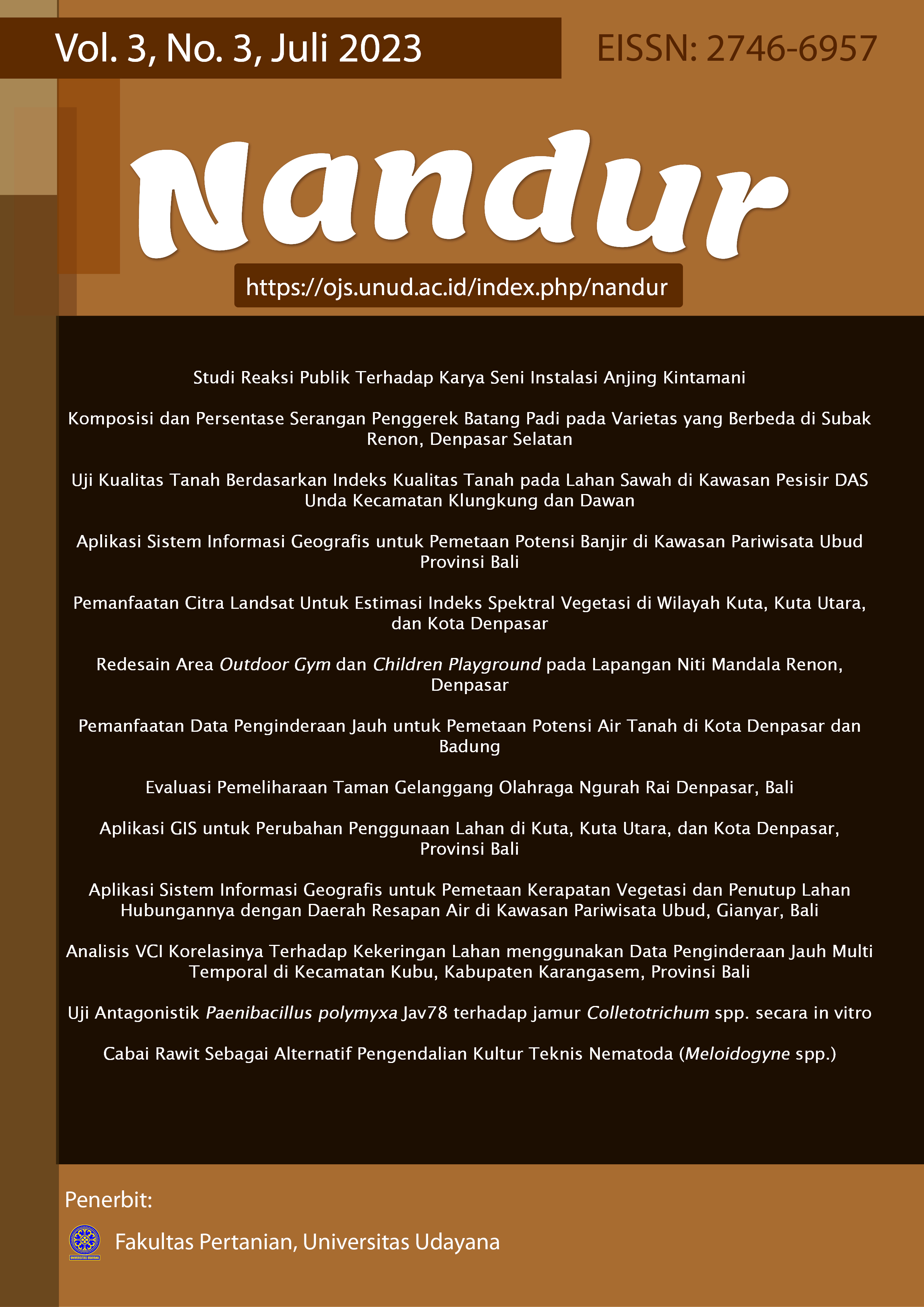Pemanfaatan Citra Landsat Untuk Estimasi Indeks Spektral Vegetasi di Wilayah Kuta, Kuta Utara, dan Kota Denpasar
Abstract
The declining amount of carbon stock occurs due to the reduction of aboveground biomass, the increase in population, and the development of urban development. This study aims to analyze changes in the spatial distribution of vegetation index, carbon stock distribution, and biomass carbon stock every 5 years from 2002 to 2022 in Kuta, North Kuta, and Denpasar areas. The method used in this research is Image processing with Partial least square (PLS) model and random forest (RF). The data used in the study include Landsat images with recording in 2002, 2007, 2012, 2017 and 2022. The results of this study show that Kuta and Denpasar areas have different values and patterns of spectral index changes every 5 years for the vegetation index used. The area of change in the spatial distribution of carbon stocks increased every 5 years from vegetated to non-vegetated areas. The biomass carbon stock decreased over 20 years from very low, low, medium and high categories to non-vegetated. This condition occurs due to the development of built-up land in the tourism area of Kuta, North Kuta, and residential areas in Denpasar City.
References
Gitelson, Anatoly A. (2004). “Wide Dynamic Range Vegetation Index for Remote Quantification of Biophysical Characteristics of Vegetation.” Journal of Plant Physiology 161 (2): 165–73.
Gitelson, Anatoly A, Andrés Viña, Verónica Ciganda, Donald C Rundquist, and Timothy J Arkebauer. (2005). “Remote Estimation of Canopy Chlorophyll Content in Crops.” Geophysical Research Letters 32 (8).
Jordan, Carl F. (1969). “Derivation of Leaf‐area Index from Quality of Light on the Forest Floor.” Ecology 50 (4): 663–66.
Kaliky, Fitriyanti, and Syarif Ohorella. (2011). “Biomassa Dan Karbon Dibawah Permukaan Tanah Tegakan Sengon (Paraserianthes Falcataria L. Nielsen) Pada Lahan Agroforestry.” Jurnal Agrohut 2 (2): 110–18.
Kawamuna, Arizal, Andri Suprayogi, and Arwan Putra Wijaya. (2017). “Analisis Kesehatan Hutan Mangrove Berdasarkan Metode Klasifikasi NDVI Pada Citra Sentinel-2 (Studi Kasus: Teluk Pangpang Kabupaten Banyuwangi).” Jurnal Geodesi Undip 6 (1): 277–84.
Liu, Hui Qing, and Alfredo Huete. (1995). “A Feedback Based Modification of the NDVI to Minimize Canopy Background and Atmospheric Noise.” IEEE Transactions on Geoscience and Remote Sensing 33 (2): 457–65.
Nuarsa, I Wayan, I Gusti Alit Gunadi, and I Made Sukewijaya. (2018). “Integrasi Teknologi Pengideraan Jauh Dan Sistem Informasi Geografis Untuk Estimasi Serapan Dan Emisi CO2 Di Kota Denpasar.” Ecotrophic 12 (2): 240–50.
Otgonbayar, Munkhdulam, Clement Atzberger, Jonathan Chambers, and Amarsaikhan Damdinsuren. (2019). “Mapping Pasture Biomass in Mongolia Using Partial Least Squares, Random Forest Regression and Landsat 8 Imagery.” International Journal of Remote Sensing 40 (8): 3204–26. https://doi.org/10.1080/01431161.2018.1541110.
Pareta, Kuldeep, and Upasana Pareta. (2011). “Quantitative Morphometric Analysis of a Watershed of Yamuna Basin, India Using ASTER (DEM) Data and GIS.” International Journal of Geomatics and Geosciences 2 (1): 248–69.
Purnomohadi, Ning. (2006). “RTH Sebagai Unsur Utama Tata Ruang Kota.” Departemen Pekerjaan Umum-Ditjen Penataan Ruang. Jakarta.
Qi, Jiaguo, Abdelghani Chehbouni, Alfredo R Huete, Yann H Kerr, and Soroosh Sorooshian. (1994). “A Modified Soil Adjusted Vegetation Index.” Remote Sensing of Environment 48 (2): 119–26.
Rouse, John Wilson, Rüdiger H Haas, John A Schell, and Donald W Deering. (1974). “Monitoring Vegetation Systems in the Great Plains with ERTS.” NASA Spec. Publ 351 (1): 309.



